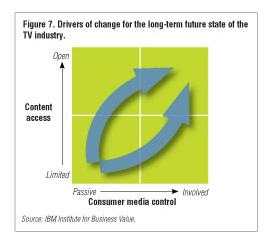TV: Fast forward to television in 2012

In “TechCrunch vs. paidContent or Web 2.0 vs. New Media” I underscore how the two recent NYC parties held by the blogging networks reflected the vastly different editorial, and business, approaches of their founders, Michael TechCrunch Arrington and Raft paidContent Ali.
The party “takeaways” also differed: An “I am in in bed with TechCrunch” tee-shirt was the parting gift at Arrington’s meetup, while Ali’s mixer offered a 24 page IBM Institute for Business Value thought piece for post event enjoyment.
IBM’s Media and Entertainment message? The end of television as we know it.
FAST FORWARD TO 2012 “ADVANCED USER” TV EXPERIENCE
I am in digital-electronics-gadget nirvana. My home sports a fully wireless broadband Internet environment, where content moves freely among the home serve, several multiple high definition screens, the office PC and the mobile devices that I continually upgrade.
I regularly acquire favorite TV shows either from Internet search engines, the video -telecommunications provider’s on-demand archive or fully-loaded Internet video destinations. I can’t remember the last time I made “appointment TV,” since I download or watch on replay from my multi-room digital video recorder every important program or episode. A Bluetooth-like signal on my cell phone triggers the logon for my media center system. When ready to watch TV, I am greeted with a mosaic screen with titles of favorite TV channels, suggested programs from the last 24 hours, season’s passes and tailored on-demand choices.
My home network offers different on-demand pricing packages, dependent on the number of times I plan to watch, copy or download, and whether the content is a preview. When not skipping through, I am more amused than ever by advertising, particularly since it is tailored for me and comes with relevant links, add-ons and a variety of purchase options within the commercial itself. While all of these options can feel overwhelming to some, I view them as a challenge with a large pay-off.

"Audiences are becoming increasingly fragmented, splicing their time among myriad media choices, channels and platforms. For the last few decades, consumers have migrated to more specialized, niche content via cable and multichannel offerings. Now, with the growing availability of on demand, self-programming and search features, some experiences are moving beyond niche to individualized viewing. With increasing competition from convergence players in TV, telecommunications and the Internet, the industry is confronting unparalleled complexity, dynamic change and pressure to innovate."
Today is the beginning of “the end of tv as we know it” and the future will only favor those who prepare now via six priority actions: Segment, Innovate, Experiment, Mobilize, Open and Reorganize.
SEGMENT: Invest in divergent strategies and supply chains for bimodal consumer types. Identify, develop and continually refine data-driven user profiles in order to optimize product and service development, distribution, marketing messaging and service migration.
INNOVATE: Innovate business models, pricing, windows, distribution and packaging by creating, not resisting—wider consumer choice. Take risks today to avoid losing position over the long term.
EXPERIMENT: Develop, trial, refine, roll-out. Repeat. Conduct ongoing market experiments, alone and with partners, to “study “real life” consumer preferences. Invest in new measurement systems and metrics for the on demand world of tomorrow.
MOBILIZE: Create seamless content mobility for users who require on-the-go experiences. Help ensure easy synchronization across devices and without required user modification.
OPEN: Drive open and standards-based content delivery platforms to optimize content and revenue exploitation, and to create high business flexibility and network cost-efficiency. Position open capabilities to bolster digital content protection with consumer flexibility, and for plug-and-play business upgrades necessary in the fast-changing marketplace.
REORGANIZE: Reassess your business composition against future requirements. Identify core competencies needed for future competitive advantage. Isolate non-core business components for outsourcing, consolidation or partnering. From an external perspective, reconfigure the business to leverage market and financial levers to buy, build or team for future competitiveness.